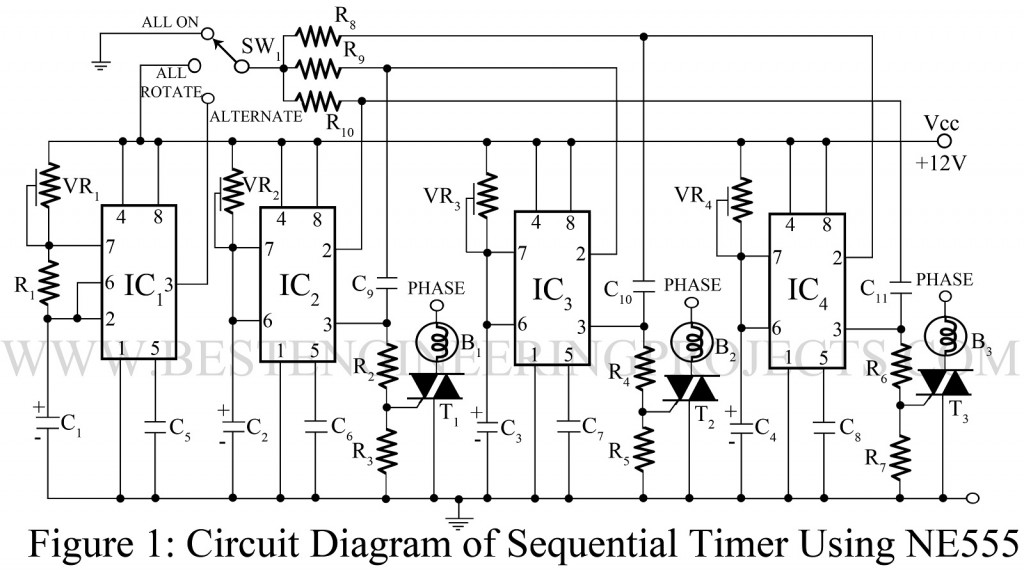This is a simple sequential timer circuit using NE555 which can be used for psychedelic light, decoration in shops, advertisement boards at night, and parties. The circuit is similar to those published earlier, except for the fact that it incorporates some additional features.
Circuit Description Sequential Timer Using NE555
In the circuit sequential timer circuit IC2, IC3 and IC4 are used as monostable multivibrators. The trigger terminals (pins 2) of these ICs are connected in a chain to the previous ICs through an RC differentiator network (0.022 µF capacitor and 22 KΩ resistors). IC1 is used as an astable multivibrator with an adjustable duty cycle and period.
To understand the functioning of the sequential timer circuit, supposed the circuit is put in the ‘all rotate’ position and lamp L1 is on. When lamp L1 goes to the off state, as pin 3 of IC2 goes to the low state, it triggers IC3 through C9 and R9 differentiator, and thus lamp L2 switches on. In the next period, lamp L2 while going off switches on lamp L3 and so on, thus completing the chain.
When the switch SW1 is in an ‘all on’ state, the trigger terminal of each IC2, IC3 and IC4 is clamped to the ground and thus the output of each goes high, making each of the lamps L1, L2, and L3 switch on. This state is useful in checking for fused lamps.
Since IC1 is put as an astable multivibrator, when switch SW1 is put to alternate position, for some time the lamps rotate and then for some time all of them glow simultaneously. For the given component values, the period can be increased to about four seconds. This period can be adjusted by VR1.
The effect on the ‘alternate’ position comes from the fact that in this case trigger terminals of IC2, IC3 and IC4 are put to ‘all on’ and ‘all rotate’ positions automatically alternately because the output of IC1 goes to Vcc, and ground-level alternately.
Calibration of Sequential Timer Circuit Using NE555
Adjustment of the unit is simple. Put SW1 to all rotated positions and adjust VR2, VR3, and VR4 so that each lamp glows for equal time, or the effect is most eye-appeasing. Then put the switch to an alternate position and adjust VR1 for the most pleasing effect.
If many small lamps are to be used, a suitable sequence for connection of the lamps can be L1 L2 L3 L1 L2 L3—–.
Since the monostable IC2, IC3 and IC4 require an initial trigger to be cycling, the circuit may not operates if switch SW1 is in the ‘all rotate’ position initially. In this case, switch SW1 to the ‘all on’ or ‘alternate’ position momentarily before switching back to the ‘all rotate’ position.
Check out other decoration project posted in bestengineeringprojects.com
- Christmas Music and Decoration using Arduino
- Christmas Decoration Circuit With Music
- Running and Spellar Effects of Light Circuit
PARTS LIST OF SEQUENTIAL TIMER CIRCUIT USING NE555
|
Resistor (all ¼-watt, ± 5% Carbon) |
|
R1 = 200 KΩ R2, R4, R6 = 1 KΩ R3, R5, R7 = 10 KΩ VR1 = 500 KΩ VR2 – VR4 = 100 KΩ |
|
Capacitors |
|
C1 = 10 µF, 12V (Electrolytic Capacitor) C2 – C4 = 2 µF, 12V (Electrolytic Capacitor) C5 – C8 = 0.01 µF (Ceramic Disc) C9 – C11 = 0.022 µF (Ceramic Disc) |
|
Semiconductors |
|
IC1 – IC4 = NE555 (Timer IC) T1 – T3 = OT104 (400V, 1A Transistor) |
|
Miscellaneous |
|
L1 – L3 = max 150W lamps SW1 = Rotary switch |

What are the values of R8, R9 and R10 resistors?
What are the values of R8 – R10???
hi i m making sequential timer for my project . can i use ic555 instead of NE555??
Yes, you can.
In-fact NE555, LM555 etc. all are same